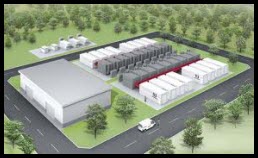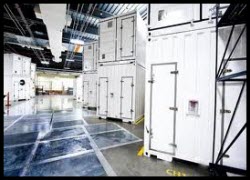The challenge with data center capacity management lies not in what to do, but how to do it in a dynamic and complex environment. Traditional data centers typically were housed in one giant room with a single, integrated power and cooling system to service the entire room. This meant the energy expended to cool the room was fairly constant regardless of the actual IT load. Today’s modularized data center architecture is more energy efficient. It is designed to scale with the deployment volume of IT equipment. As IT equipment and computational workloads fluctuate with business demand, so too should the power and cooling of the data center.
Modularization helps the data center’s power and cooling systems run truly proportional to the computational demand and, thus, is less wasteful. By optimizing infrastructure performance, more servers can be supported in the data center with the same power and cooling. To fully appreciate its impact on capacity gains, first consider the how the principles of modularization can be applied throughout the entire facility:
 Physical Layout – Just as one manages power usage in a home by turning out the lights in unoccupied rooms, one can also manage data center power. By compartmentalizing the data center into energy zones or modules, with independent controls for power, cooling, and humidity, each module can be independently “lit up” as needed. Modularization can be achieved by erecting walls, hanging containment curtains, or by using pods, i.e., enclosed compartments of IT racks that employ a centralized environmental management system to provide cool air at intake and keep warm air at the exhaust.
Physical Layout – Just as one manages power usage in a home by turning out the lights in unoccupied rooms, one can also manage data center power. By compartmentalizing the data center into energy zones or modules, with independent controls for power, cooling, and humidity, each module can be independently “lit up” as needed. Modularization can be achieved by erecting walls, hanging containment curtains, or by using pods, i.e., enclosed compartments of IT racks that employ a centralized environmental management system to provide cool air at intake and keep warm air at the exhaust.
IT Systems Architecture – IT infrastructure can be modularized, and should be done in conjunction with IT staff and end-user customers (business units) who own the applications deployed on servers. IT modularization involves grouping together servers, storage, and networking equipment that can be logically deployed in the same module. For example, when business computational demand is low, all corporate applications—such as the corporate intranet, internal email, external Web presence, e-commerce site, ERP applications, and more—can be deployed on the same module while the other modules in the data center remain “unlit” to save energy. As the business grows, more servers can be deployed and additional modules commissioned for IT use. For instance, all corporate intranet applications can be deployed in one module with external applications deployed in another module.
 Power and Cooling Infrastructure – Right-sizing the facilities infrastructure follows the modularization of the physical layout. As the modules—zones or pods—are created
Power and Cooling Infrastructure – Right-sizing the facilities infrastructure follows the modularization of the physical layout. As the modules—zones or pods—are created
for the physical layout, the power and cooling infrastructure are deployed in corresponding units that independently service each module. Separate UPSs, PDUs and power systems, along with CRAC units, condensers, or chillers, are sized appropriately for each module. This allows the scalable expansion of the facilities infrastructure as IT equipment expands.
The principles of modularization summarized above are proven optimization strategies that can extend the life of the data center. Optimizing in near real-time delivers a higher yield from existing resources. It enables us to get more utilization out of power, cooling and space.
If your data center infrastructure management tools fall short enabling continuous optimization, then let us show you how OpenData can help in this 20-minute Modius OpenData webcast: http://info.modius.com/data-center-monitoring-webcast-demo-by-modius
